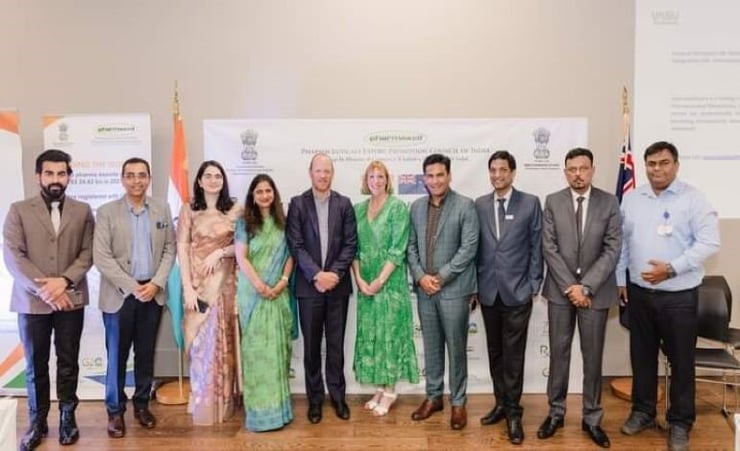INDIAN PHARMA INDUSTRY EYES OCEANIA MARKET

The India-New Zealand Pharma Business Meet, hosted by the Indian High Commission in Wellington on February 10, provided a forum for pharmaceutical companies from India to engage in business-to -business (B2B) meetings with their Kiwi counterparts aimed at expanding the footprint of the Indian pharmaceuticals industry in the Oceania region.
A delegation of around 22 companies, led by the Pharmaceuticals Export Promotion Council of India (Pharmexcil), touched down in Australia and New Zealand as part of its itinerary to promote Indian pharma products in the region.
Pharmexcil is the apex body instituted under the foreign trade policy of the Ministry of Commerce and Industry, Government of India, to oversee pharma exports. Its headquarters is in Hyderabad, India.
The visiting delegation comes in the backdrop of India’s bid to consolidate its presence in the global pharmaceuticals market, following its pivotal supply of vaccines to the world to combat the Covid pandemic.
Between 65 to 70 per cent of the World Health Organisation’s (WHO) vaccines requirement are sourced from India, earning it the moniker “Pharmacy of the world.”
At the Wellington meet, High Commissioner of India to New Zealand Neeta Bhushan was accompanied onstage by Pharmexcil Director (Regulatory Affairs) Lakshmi Prasanna, NZ Pharmac Procurement and Contracts Manager Gillian Anderson, Medsafe Group Manager Chris James and India-New Zealand Business Council (INZBC) Treasurer Jay Changlani.
Welcoming the delegates, Indian High Commission Second Secretary (Politics and Commerce) Manoj Kumar Sahu said: “India has played a part during the pandemic by providing free vaccines and medicines to many countries in the world. New Zealand has also done its bit. So joint initiatives and cooperation among countries are the need of the hour. This exchange between Indian and Kiwi pharma companies will lead to very positive outcomes, I’m sure.”
In her keynote address, High Commissioner Bhushan described India as the “fastest growing large economy at the moment” that was on a trajectory to becoming a “five trillion economy” and then a “10 trillion economy.” She said the Covid pandemic highlighted India’s role as one of the major suppliers of medicines, medical equipment and vaccines around the world.
“India and New Zealand may be geographically distant but the mutual goodwill between the two countries is immense. We have a big diaspora that contributes in bringing the two countries together, especially businesses,” she noted.
High Commissioner Bhushan referred to New Zealand Foreign Minister Nanaia Mahuta’s visit to Mumbai where she met business leaders to promote collaboration between the two countries. “The buzz word now is mutually beneficial collaborations.”
The high commissioner pointed to the “18 or 19 per cent increase in our pharma exports to New Zealand in the last year alone.”
“India offers rule of law, transparency and provides generic medicines to more than 200 countries. Indian companies rank among the top 25 generic companies in the world.”
Describing New Zealand as a “somewhat new market,” High Commissioner Bhushan said Indian suppliers have been going to “the EU, the UK, Canada , the US, Mexico ……… all those markets which require a very high level of quality maintenance and research.”
The high commissioner especially referenced an Indian company that had established a base in New Zealand and was supplying products locally as well as to nearby countries. She said Indian companies could access the Oceania market by emulating the example of that company.
The high commissioner concluded her address by thanking Second Secretary Sahu, Ishant Ghulyani [who emceed the event] and her other colleagues for putting together the “successful and productive B2B meetings.”
Pharmexcil regulatory affairs director Lakshmi Prasanna opened her remarks by noting that the “Oceania region has been identified as a potential market for Indian pharma industries to tap into.” New Zealand was the second largest export destination for Indian pharmaceuticals in that region. Presentations from Pharmac and Medsafe provided insights to Indian companies on New Zealand’s regulatory authority, she observed.
Pharmac procurement and contracts manager Gillian Anderson followed up by briefing the delegates on the role of Pharmac in the New Zealand health system. Pharmac was the central purchasing agency for New Zealand for the funded market, she explained “Our mandate is to secure for eligible people (among the funded public) the best health outcomes that are reasonably achievable from pharmaceutical treatment,” she told the delegates. That covered medicines, medical devices, vaccines and blood products for people with haemophilia. The funding allocated for purchasing medicines and equipment stood at "NZD 1.18 million for this financial year and NZD 1.2 million for the next financial year,” Anderson said. She shed light on the tender system of the procurement process followed in New Zealand and stressed that continuity of supply was key since New Zealand was “at the bottom of the world.”
Chris James, group manager of Medsafe, spoke next. “Medsafe is responsible for the regulation of medicines and medical devices in New Zealand,” he told the delegates. The agency’s key role was to ensure that “the benefits outweigh the risks” for the New Zealand public for the medicines that are used in NZ.
INZBC treasurer Jay Changlani explained to the delegates that his organisation aimed at providing a platform for Indian and Kiwi businesses to network together and get the business outcomes they hoped for. He alerted the audience to a report published last year that outlined the opportunities and challenges for Indian businesses looking to export into New Zealand.
The session concluded with the presentation of mementos to the speakers, which was followed by B2B meetings between the Indian and Kiwi delegates.



